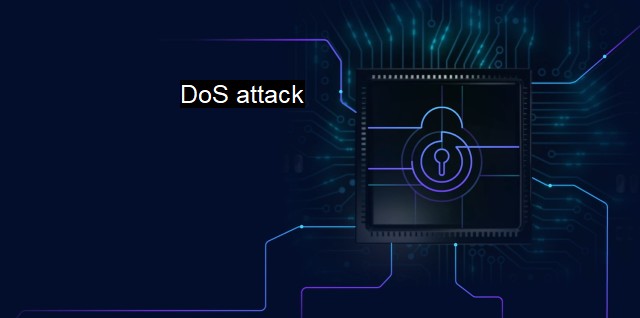What is DoS attack?
Shielding Against the DoS Attack: Exploring Cybersecurity Measures with Antivirus Software
A Denial of Service (DoS) attack is a particular menace that overloads a targeted system, effectively disrupting the functioning of networks, websites, or services. As a result, legitimate users are denied access to the resources or services they usually have. A large component of cybersecurity solutions and antivirus programs revolves around addressing these types of challenges.To fully understand what a DoS attack is, its necessary to delve into its details. Attackers carry out DoS attacks by overwhelming servers, systems, or networks with traffic. the attacker manipulates the system to send massive amounts of requests to the targeted network, disrupting its regular operations and eventually making it unavailable to intended users. The inundation can result in crashes or significantly slow-down systems, causing inconvenience and frustration among users and interrupting businesses or public operations.
There are several variants of a DoS attack, with the most common one being the Distributed Denial of Service (DDoS) attack. Unlike regular DoS attacks where only one system is used to attack the target, DDoS is a coordinated effort channeling traffic from multiple computer systems. Due to its widespread nature, DDoS attacks could affect an extensive range of Internet users. Even the anti-malware systems placed strategically can sometimes fail to block them due to their stealthy infiltration techniques and vast source networks.
The attack's purpose often depends on the perpetrator's motivations, which could range from vandalism and activism to cyberwarfare and competition. Sometimes, perpetrators launch these attacks merely to create havoc without a hidden agenda. In other instances, it could be from rivals intending to injure the target's reputation or competition trying to redirect users to their websites.
Regardless, even though a DoS attack does not necessarily result in loss of data or breach of security, the adverse effects can be severe for organizations. The downtime caused by such attacks could lead to loss of business, tarnishing of reputation, and increased operational expenses. Depending on the target's nature, the implications of a DoS attack on operational-critical services could even be life-threatening.
Protecting a system against a DoS attack involves diverse strategies. Strong cybersecurity solutions are required, encompassing antivirus and anti-malware software, firewalls, updating and patching deficiencies in the system, and creating redundancies in the network's critical parts. In addition to that, system administrators often employ strategic methods like rate limiting, traffic shaping, and traffic regulation via routers and switches. They also implement an Intrusion Detection System (IDS) or an Intrusion Prevention System (IPS) to identify and fend off these attacks.
DoS attacks are part and parcel of the challenges in the cybersecurity world and are continually evolving. Because of this, companies construct proactive cyber-defences and have disaster recovery plans in hopes of mitigating risks and losses. cyber laws are put in place to deter potential perpetrators. Penalties for executing DoS attacks can be intense, ranging from steep fines to imprisonments, contingent on the attack severity.
DoS attacks and their derivatives are substantial threats in the cybersecurity realm that need to be taken seriously. With the continuously expanding digital landscape creating further opportunities for these threats, it is paramount to continuously evolve cybersecurity standards. Using comprehensive strategies and proactive practices, the risks associated with DoS attacks can be reduced, ensuring the operational stability of the Internet for both users and operators.

DoS attack FAQs
What is a DDoS attack?
A DDoS attack, short for Distributed Denial of Service, is a type of cyber attack where multiple compromised systems or devices are used to flood a targeted system or network with traffic in an attempt to make it unavailable to its users.How does a DDoS attack work?
A DDoS attack works by overwhelming the targeted system with a high volume of traffic, often from multiple sources. This can be achieved through various means such as exploiting vulnerabilities in commonly used software, taking advantage of weak passwords, or using botnets to coordinate multiple devices to attack the target at once.How can I protect myself against a DDoS attack?
There are several steps you can take to protect yourself against a DDoS attack, such as investing in a reliable anti-DDoS solution or service, ensuring your systems are patched and up-to-date, regularly monitoring your network traffic for unusual activity, and implementing rate limiting and filtering mechanisms to block traffic from known malicious sources.What are the potential consequences of a DDoS attack?
The consequences of a DDoS attack can vary depending on the severity and duration of the attack, but they often include significant downtime and loss of revenue for the targeted organization, as well as damage to its reputation and loss of customer trust. In addition, DDoS attacks can also be used as a smokescreen to distract security teams from other malicious activity, such as data theft or network infiltration.| | A | | | B | | | C | | | D | | | E | | | F | | | G | | | H | | | I | | | J | | | K | | | L | | | M | |
| | N | | | O | | | P | | | Q | | | R | | | S | | | T | | | U | | | V | | | W | | | X | | | Y | | | Z | |
| | 1 | | | 2 | | | 3 | | | 4 | | | 7 | | | 8 | | |||||||